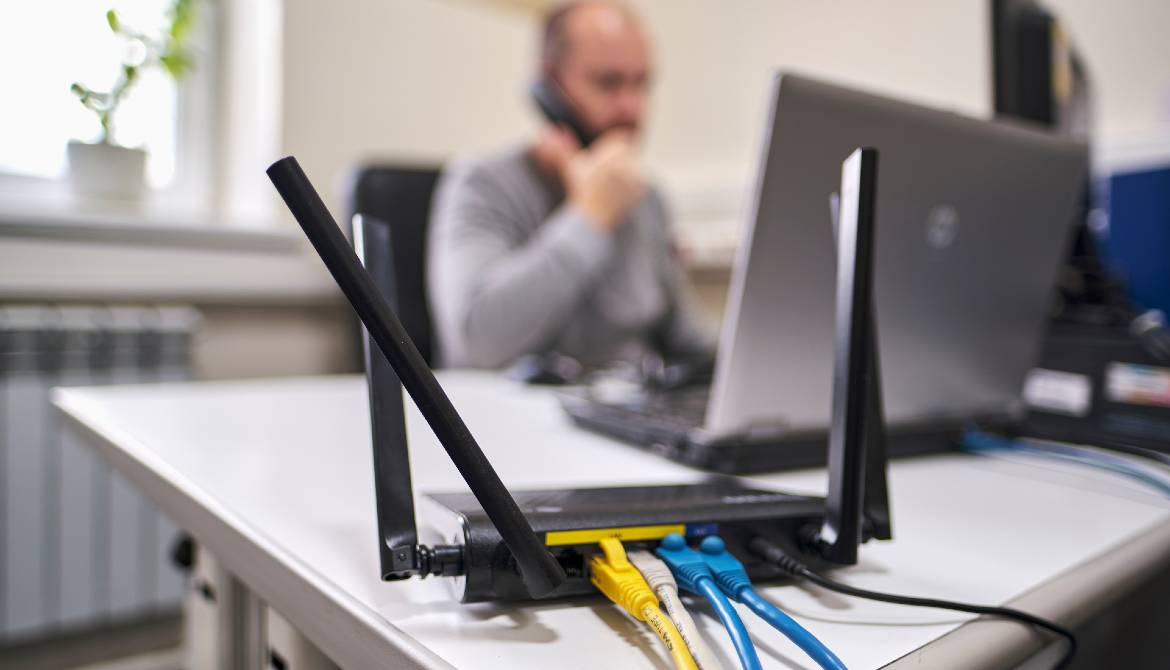6 minutes
Alabama ONE CU leverages innovations to enable growth while benefiting members and staff.
It’s no secret that business growth and modernization initiatives frequently require technology investments. Here at Alabama ONE, it’s been the same.
When the leadership at our Tuscaloosa, Alabama-based institution set out in 2017 to more than double our branch footprint, enter new geographies, acquire other entities and provide modern digital banking experiences, it required re-evaluating our wired, wireless, and branch networking approach.
At that time, we were facing long-standing challenges with providing high performance connectivity in a region where limited physical infrastructure dominated our rural service areas. Traditionally, this meant our backbone options were limited to a type of telecom line called MPLS—multiprotocol label switching.
Although tried-and-true, MPLS is expensive and inflexible—and typically requires several months for a telecom company to supply. As we needed to become more agile, reduce costs and speed branch openings, ending our dependence on MPLS was critical.
In addition, our wired network was aging, and we lacked enterprise-class Wi-Fi. It was simply time to refresh those capabilities as well.
With these basic requirements in hand, we contacted our trusted local partner, Veristor, to assist us with selecting and deploying technology solutions that could address our needs.
SD-WAN Eliminates MPLS
For an alternative to MPLS, we evaluated new technology called software-defined wide-area networking. As it sounds, this innovation for connecting branches relies on software rather than using old-school hardware methods, like MPLS.
Adopting SD-WAN would enable us to eliminate MPLS in favor of using more flexible and cost-effective backbone offerings, such as fiber internet, cable broadband and even cellular, in whatever combination made sense for a given location.
The technology also gave us proactive control of branch connectivity and fast issue resolution, such as quickly transferring a location to a backup connection if its primary connection is cut, rather than suffering an outage and then waiting—sometimes for days—for a service provider to respond.
To determine the best solution for our needs, we contacted existing users of the leading SD-WAN solutions. We discovered many more real-world use cases and satisfied customers of a product called EdgeConnect by Aruba, a Hewlett Packard Enterprise Company.
High-Performance Connectivity
For Wi-Fi, we needed a solution that would enable various digital banking capabilities, such as tablet-based member assistance and interactive video services.
For these needs, we conducted another evaluation. Ultimately, we selected Aruba’s Wi-Fi 6 solution due to our testing and its reputation for market leadership, reliability, ease of administration and flexible deployment options.
In particular, Aruba’s Wi-Fi includes state-of-the-art cloud-delivered management capabilities. This compared favorably to using the traditional hardware-based “controller” approach, which adds a layer of expense and complexity. The competing solution only offered the more costly and complex traditional method. Plus, the overall licensing structure with Aruba was more attractive as it’s all-inclusive, rather than ala carte.
On the wired side, Veristor suggested rounding out our deployment with Aruba’s newest line of switches, called Aruba CX. With advanced automation built into every switch, this product line simplifies wired networking and includes Aruba’s characteristically intuitive dashboards.
Although we’re not yet large enough to use many of CX’s resident capabilities, our growth trajectory will make the investment advantageous long term.
ROI Rapidly Achieved
The immediate rewards we’ve realized from our new networking infrastructure cannot be understated. They range from achieving return on investment within the first year to supporting our ongoing member services and growth goals.
No longer relying on a telecom supplier to provide an MPLS connection has helped us accelerate growth by slashing branch deployment times from several months to several days. In just one instance, we acquired a branch from another institution and transitioned it from their brand to ours over a three-day holiday weekend.
Eliminating MPLS is also saving us approximately 70% per month on telecom costs, a benefit that will continue accruing as we bring more sites online.
Delivering Modern Experiences
In terms of member service and employee experiences, the advantages are equally impressive.
At all our branches, we’ve equipped our personal bankers with tablets that enable starting a new member, loan or other application anywhere in the lobby. At locations with high traffic counts, we’ve reduced or eliminated standing in a teller line by enabling all employees to complete teller transactions on their mobile device.
Also, with our new networking technologies supporting digital communications services like interactive teller machines, we’re providing across-the-desk branch experiences to all members, every day. This includes many rural locations where we formerly offered limited live services.
In addition, none of our employees—corporate or branch—are tethered to a workstation. By issuing laptops to everyone, our workers can move around within a location or work at another location depending upon staffing needs. This significantly optimizes our human capital.
Centralized, Automated Management
From an IT perspective, the intelligence built into our wired, wireless and SD-WAN technologies enable us to manage networking infrastructure centrally, significantly reducing overhead. This includes pushing out any new configurations, which are automatically applied, as well as quickly troubleshooting and resolving issues.
Previously, highly trained technologists travelled as much as an entire business day, round trip, to our more distant locations just to spend a few minutes remediating an issue or applying an update. By reallocating resources from driving to engineering, we can concentrate on value-added projects for achieving our institution’s business goals.
However, our troubleshooting needs have been few as the Aruba solutions just work.
Deploying in Three Easy Steps
Standardizing on Aruba enabled completing each of the three networking technology deployments quickly and uneventfully, as we benefitted from intuitive management dashboards and a wealth of customizable configuration templates.
In fact, each project proceeded so smoothly that our IT executive was amazed when we told him there were no significant issues with our Aruba technology. Where there were delays, it was with other aspects of each project.
Here are the three steps we took to achieve success:
Step 1: Deploy SD-WAN. We began by deploying the SD-WAN in early 2020, as we could implement it across our existing network. We conducted a couple months of testing to ensure our policies were sufficiently robust and the deployment templates would implement configurations across our data centers, hubs, and branch locations.
The actual deployment of the SD-WAN required about two months and was completed during the initial weeks of the COVID-19 closures. We immediately received enthusiastic feedback on application performance, affirming we were on the right course.
Step 2: Roll out Wi-Fi. We quickly followed SD-WAN with Wi-Fi, which took less than 60 days for the 18 sites we had at the time. After configuring and staging the equipment for each branch at our headquarters, we simply plugged it in on site.
Step 3: Refresh data centers. Finally, we turned to our data centers, which include a live and a failover site. Veristor helped us with the deployment, including the switch installation. It took only minutes for our staff to learn the management interface, which was particularly notable for those of us in the IT industry.
Deploying our SD-WAN first proved advantageous as we used the technology to speed the wired deployment. We simply instructed the SD-WAN to automatically apply the configurations from our main data center to the failover location, eliminating hours of time-consuming manual effort.
Beating the Pandemic
Today, we’re supporting 22 branches, doubling from where we began, with more openings and acquisitions on the horizon.
While many institutions put IT projects on hold during the first phases of the pandemic, we credit our new SD-WAN, Wi-Fi, and wired networking technologies with allowing us to continue pursuing our expansion strategy.
By leveraging these technologies, we’re not only achieving our institution’s goals but also have weathered the pandemic to emerge as a stronger, larger, more agile institution with a positive future ahead.
Bobby Umfress II is director/IT infrastructure and operations at $985 million Alabama One Credit Union, an award-winning, full-service financial institution based in Tuscaloosa, Alabama. In his current role, Umfress is responsible for infrastructure, operations, and ATM teams. His experience drives forward-thinking decision-making to solve complex, high transactional technical challenges, which ensures business effectiveness and continued improvement, all while focusing on being consistently innovative and providing exceptional member experience. He has more than 23 years of experience in information technology and systems management.






